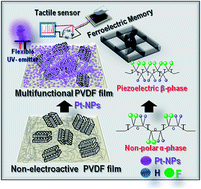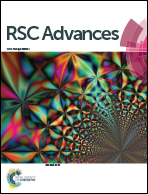The in situ formation of platinum nanoparticles and their catalytic role in electroactive phase formation in poly(vinylidene fluoride): a simple preparation of multifunctional poly(vinylidene fluoride) films doped with platinum nanoparticles†
Abstract
A simple route for in situ platinum nanoparticles (Pt-NPs) synthesis is described. A trace amount (0.048 mM) of platinum precursor promotes the electroactive phase transformations (α → β and γ-phase) in poly(vinylidene fluoride) (PVDF) implying a new catalytic role of Pt-NPs. Furthermore, a complete conversion (∼99%) to the electroactive phase is achieved by simply controlling the platinum precursor amount. The PVDF film doped with Pt-NPs exhibits various functionalities, i.e., human touch response, enhanced ferroelectric remnant polarization and intense photoluminance in the UV-region. Apart from conventional piezoelectric sensors and actuators, it naturally lends itself to futuristic applications as a vibration based energy harvester, a ferroelectric non-volatile memory element and a large area coverage lightweight foldable optoelectronic device.


 Please wait while we load your content...
Please wait while we load your content...